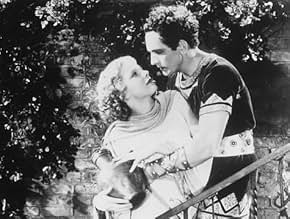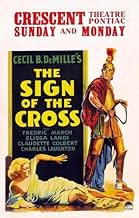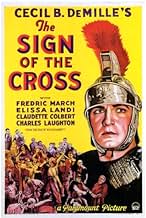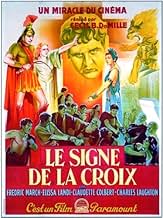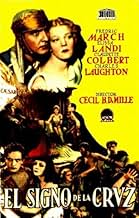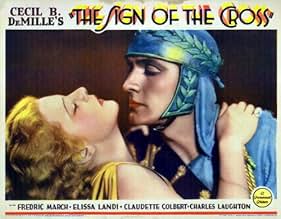CALIFICACIÓN DE IMDb
6.8/10
2.9 k
TU CALIFICACIÓN
Un soldado romano se debate entre su amor por una mujer cristiana y su lealtad al emperador Nerón.Un soldado romano se debate entre su amor por una mujer cristiana y su lealtad al emperador Nerón.Un soldado romano se debate entre su amor por una mujer cristiana y su lealtad al emperador Nerón.
- Dirección
- Guionistas
- Elenco
- Nominado a 1 premio Óscar
- 3 premios ganados y 1 nominación en total
Joyzelle Joyner
- Ancaria
- (as Joyzelle)
Robert Seiter
- Philodemus
- (as Robert Manning)
Opiniones destacadas
One of the very first and one of the very best Roman epics on screen filled with DeMille's splendor!
A comment on the original 1932 version.
Pagan Rome, the third night of the great fire. Emperor Nero (Charles Laughton) unjustly condemns Christians of burning the eternal city and sentences many of them to martyrdom. He does not realize that through this deed he unconsciously opens for them a wonderful glory in a better world. The struggle between the sign of the Roman eagle of decadent Nero's times and the sign of the cross begins, this is, symbolically, the endless struggle between those with "delicious debauchery" as the sole aim of life (the lifestyle Nero's times promoted) and those heading for everlasting virtues like love, piety, forgiveness, and purity of heart. Cecil B DeMille's THE SIGN OF THE CROSS, being the first sound biblical epic after his silent KING OF KINGS (1927) is, though more than 70 years old, a great spectacle, still one of the most entertaining Roman epics, except for QUO VADIS (1951), SPARTACUS (1960), and BEN HUR (1959).
GREAT CAST: The outstanding cast in the movie are its strongest point. Claudette Colbert's portrayal of wicked, lustful Poppaea is gorgeous. The same can be said about Charles Laughton who portrays Nero as a really decadent emperor, entirely flooded in debauchery and all sorts of sinful lusts. There have been more portrayals of this cruel pair (Poppeae and Nero), but theirs from DeMille's film is real feast for the soul. Therefore, they are even more memorable than Elissa Landi and Fredric March playing the main roles of Mercia and Marcus. Indeed, March as Marcus Superbus does a good job, especially in the way he shows a change of heart from a mocker to a believer. Elissa Landi presents Mercia's innocence and virtues memorably. But they are not that terrific as Colbert and Laughton. As far as performances are concerned, it is also important to mention Joyzelle as "the most wicked and talented woman in Rome", Ancaria. The scene of her seduction is truly well played. The dance of the Naked Moon that Ancaria seduces on Mercia is disturbed by Christians singing in a dungeon. MORAL MESSAGE: That scene clearly expresses the fact I have mentioned at the beginning: the universal struggle between two groups of people with two different aims in life. I think that DeMille also wanted to show this moral in another scene: the meeting of two old Christian men, Favius and Titus sent by Paul to Rome. One of them draws the sign of the cross on the ground, which is later trodden on by many people walking in the square.
SIMILARITY TO ANOTHER EPIC: A significant fact is that the content of the movie is strikingly similar to another Roman epic, made almost 20 years later, QUO VADIS (1951) by Mervyn LeRoy. While QUO VADIS is based on the novel by Henryk Sienkiewicz, this film is based on a play by an English playwright, Wilson Barrett. Both films, however, present the 1st century Rome, in particular, spreading Christianity in the cruel times of Nero; both films show the conversion of a Roman soldier Marcus who loves a Christian girl; both films remind us of the secret Christian meetings; both films focus on Poppaea being lustful for Marcus and demanding revenge on Christians because of jealousy (consider the moment Marcus Superbus comes to Nero to ask him to spare the life of Mercia. Nero says: If she would publicly renounce her faith... when Poppaea disturbs radically: "Not even then!") Moreover, both films show Poppaea's beautiful leopards. Finally, THE SIGN OF THE CROSS and QUO VADIS show the arena sequence, however DeMille presents much more of its gore than LeRoy in 1951.
ARENA: Alligators feeding with a young Christian woman, elephants treading on people's heads, a gorilla raping a girl tied to a wooden pillar, people crucified and burned, men fighting with bulls, bears, women fighting with dwarfs; yet lions and tigers eating Christians, and many other cruel games to the joy and lust of the viewers. Indeed, it is a film not to be watched by kids even at the beginning of the 21 century, but historically accurate and visually very well made.
ONE OF CINEMA'S MOST MEMORABLE MOMENTS: Except for the cruel arena sequence, which is still entertaining in some way, any viewer will be surprised at one scene: Poppaea's famous milk bath. That's a moment that everyone should consider while watching the film. Her sexual bath is one of the best made moments that cinema has ever seen. It is totally filled with desire and sexuality. And all thanks to the great performance by Ms Colbert. No surprise Cecil B DeMille cast her to play Cleopatra two years later, in 1934.
It's difficult to express all I feel about this movie in one review. I simply tried my best to encourage everyone to see this movie because it was an unforgettable experience for me, one of the very best Roman epics of all time. If you have already seen QUO VADIS, you will find this movie very similar but, indeed, more DeMillean. The end is very much influenced by the 1930s cinema but very touching and universally true - the absolute victory always comes in the Sign of the Cross... 9/10
Pagan Rome, the third night of the great fire. Emperor Nero (Charles Laughton) unjustly condemns Christians of burning the eternal city and sentences many of them to martyrdom. He does not realize that through this deed he unconsciously opens for them a wonderful glory in a better world. The struggle between the sign of the Roman eagle of decadent Nero's times and the sign of the cross begins, this is, symbolically, the endless struggle between those with "delicious debauchery" as the sole aim of life (the lifestyle Nero's times promoted) and those heading for everlasting virtues like love, piety, forgiveness, and purity of heart. Cecil B DeMille's THE SIGN OF THE CROSS, being the first sound biblical epic after his silent KING OF KINGS (1927) is, though more than 70 years old, a great spectacle, still one of the most entertaining Roman epics, except for QUO VADIS (1951), SPARTACUS (1960), and BEN HUR (1959).
GREAT CAST: The outstanding cast in the movie are its strongest point. Claudette Colbert's portrayal of wicked, lustful Poppaea is gorgeous. The same can be said about Charles Laughton who portrays Nero as a really decadent emperor, entirely flooded in debauchery and all sorts of sinful lusts. There have been more portrayals of this cruel pair (Poppeae and Nero), but theirs from DeMille's film is real feast for the soul. Therefore, they are even more memorable than Elissa Landi and Fredric March playing the main roles of Mercia and Marcus. Indeed, March as Marcus Superbus does a good job, especially in the way he shows a change of heart from a mocker to a believer. Elissa Landi presents Mercia's innocence and virtues memorably. But they are not that terrific as Colbert and Laughton. As far as performances are concerned, it is also important to mention Joyzelle as "the most wicked and talented woman in Rome", Ancaria. The scene of her seduction is truly well played. The dance of the Naked Moon that Ancaria seduces on Mercia is disturbed by Christians singing in a dungeon. MORAL MESSAGE: That scene clearly expresses the fact I have mentioned at the beginning: the universal struggle between two groups of people with two different aims in life. I think that DeMille also wanted to show this moral in another scene: the meeting of two old Christian men, Favius and Titus sent by Paul to Rome. One of them draws the sign of the cross on the ground, which is later trodden on by many people walking in the square.
SIMILARITY TO ANOTHER EPIC: A significant fact is that the content of the movie is strikingly similar to another Roman epic, made almost 20 years later, QUO VADIS (1951) by Mervyn LeRoy. While QUO VADIS is based on the novel by Henryk Sienkiewicz, this film is based on a play by an English playwright, Wilson Barrett. Both films, however, present the 1st century Rome, in particular, spreading Christianity in the cruel times of Nero; both films show the conversion of a Roman soldier Marcus who loves a Christian girl; both films remind us of the secret Christian meetings; both films focus on Poppaea being lustful for Marcus and demanding revenge on Christians because of jealousy (consider the moment Marcus Superbus comes to Nero to ask him to spare the life of Mercia. Nero says: If she would publicly renounce her faith... when Poppaea disturbs radically: "Not even then!") Moreover, both films show Poppaea's beautiful leopards. Finally, THE SIGN OF THE CROSS and QUO VADIS show the arena sequence, however DeMille presents much more of its gore than LeRoy in 1951.
ARENA: Alligators feeding with a young Christian woman, elephants treading on people's heads, a gorilla raping a girl tied to a wooden pillar, people crucified and burned, men fighting with bulls, bears, women fighting with dwarfs; yet lions and tigers eating Christians, and many other cruel games to the joy and lust of the viewers. Indeed, it is a film not to be watched by kids even at the beginning of the 21 century, but historically accurate and visually very well made.
ONE OF CINEMA'S MOST MEMORABLE MOMENTS: Except for the cruel arena sequence, which is still entertaining in some way, any viewer will be surprised at one scene: Poppaea's famous milk bath. That's a moment that everyone should consider while watching the film. Her sexual bath is one of the best made moments that cinema has ever seen. It is totally filled with desire and sexuality. And all thanks to the great performance by Ms Colbert. No surprise Cecil B DeMille cast her to play Cleopatra two years later, in 1934.
It's difficult to express all I feel about this movie in one review. I simply tried my best to encourage everyone to see this movie because it was an unforgettable experience for me, one of the very best Roman epics of all time. If you have already seen QUO VADIS, you will find this movie very similar but, indeed, more DeMillean. The end is very much influenced by the 1930s cinema but very touching and universally true - the absolute victory always comes in the Sign of the Cross... 9/10
Yikes! De Mille's erotic raunchy graphic and splendid SIGN OF THE CROSS made at Paramount in 1932, and his first talkie bible study is a movie you not forget. It is infamous and famous for many sights and other comments here will give you the reaction to the graphic cruelty of the truly shocking Arena/Gladiator scenes. The ridiculously entertaining asses milk bath with nipples ahoy and Claudette's milky breasts, the very funny dialog of daily life amid the splendor, the horror of the rape and torture of a teenage Christian boy, the eerie similarity to the 1932 German persecution of the European Jews, the depression era parable of the idle rich uncaring at the financial death of the 1930s masses, the dazzling costumes (no bras in Rome either), the claustrophobic street sets with rushing horses and fights in corners, all in all create an amazing action tableau like a pencil sketch bible book drawing brought to life. The film's art direction and set design and costumes are especially evocative of 'a silent epic with sound' and one easily can transfer the idea of seeing the 1925 BEN HUR with sound as SIGN OF THE CROSS favorably compares. The Arena montage scenes are really shocking. The Moon Dance is outrageous lesbian swankiness and gorgeous as all hell... well pagan hell as depicted by the morally austere Demille. Great moving wallpaper for your next party if played on a big TV and without sound with your CD collection going instead. If you agree that SIGN OF THE CROSS made in 1932 is really a 1920s silent film with dialog, have a look at FOLLOW THRU made two years earlier in 1929 and in color and as jazz modern today in it's creative style. CROSS plays like an ancient movie but FOLLOW THRU still plays new.
Great old DeMille flick about the persecution of Christians in ancient Rome. The movie starts with Emperor Nero (Charles Laughton) laughing and playing music while Rome burns. When someone reminds him that the people might hold Nero responsible, he quickly decides to blame the unpopular believers of the new Christian religion. As Christians are being rounded up and killed, Roman prefect Marcus (Fredric March) falls in love with a Christian girl (Elissa Landi). This doesn't sit well with Empress Poppaea (Claudette Colbert), who's in love with Marcus, and she conspires to have the girl arrested.
Charles Laughton gives an outrageously hammy performance and I loved every second of it. I wish he had been in the film a lot more. Fredric March is good, as always. Lovely Elissa Landi does an admirable job in probably her biggest role but she's eclipsed by Claudette Colbert. What this film is perhaps most famous for is the scene where Colbert takes a bath in donkey milk, in which we see quite a bit of what God gave Ms. Colbert to work with. She's a beautiful woman and it's a very sexy scene. The sets and costumes are great, as one expects from a Cecil B. DeMille picture. It's just a really good film, entertaining and dramatic, with some provocative bits of sex and violence that will surely please pre-Code fans. If for no other reason, see it for Colbert.
Charles Laughton gives an outrageously hammy performance and I loved every second of it. I wish he had been in the film a lot more. Fredric March is good, as always. Lovely Elissa Landi does an admirable job in probably her biggest role but she's eclipsed by Claudette Colbert. What this film is perhaps most famous for is the scene where Colbert takes a bath in donkey milk, in which we see quite a bit of what God gave Ms. Colbert to work with. She's a beautiful woman and it's a very sexy scene. The sets and costumes are great, as one expects from a Cecil B. DeMille picture. It's just a really good film, entertaining and dramatic, with some provocative bits of sex and violence that will surely please pre-Code fans. If for no other reason, see it for Colbert.
My favorite DeMille film. Charles Laughton and Claudette Colbert are delicious as the debauched emperor and empress of Rome. Prominent supporting players Arthur Hohl and Harry Beresford appeared in two horror classics (ISLAND OF LOST SOULS and DOCTOR X, respectively) the very same year. John Carradine can be seen as a condemned Christian on his way to the arena (you can also hear his voice as a spectator and as a gladiator). Very sharp viewers can also spot Dave O'Brien (a condemned Christian) and Kent Taylor (a disinterested spectator). Three famous scenes still impress today: Poppaea's milk bath; Ancaria's attempted lesbian seduction of Mercia; the outrageous arena sequence featuring beheadings, burnings, impalements, hungry crocodiles, untamed apes, bears, tigers and, of course, lions. Only C.B. could have gotten away with this in 1932! The closing cast list includes the characters Viturius, Servillius and Philodemus, but I'm not sure who they are. Viturius may have been Marcus' soldier-aide, although he doesn't look as burly as Richard Alexander. The other two must be Strabo's ugly, brutish companion and the old Christian man protective of the little orphan girl.
Believe it or not some sort of code did exist during the pre-Code era but no one felt obliged to follow it. Although lapped up by audiences the excesses on display in this extraordinary opus proved too much to bear in certain quarters and undeniably hastened the formation of the Hays Code and the crackpot Catholic League of Decency. One would hazard a guess that it is not so much the unspeakable cruelty depicted here that caused such moral outrage but the skimpy costumes and the hip-swivelling cooch dance by Joyzelle Joyner with its distinctly lesbian overtones.
Piety and Paganism are in direct opposition here and although Mr. De Mille is seen to be on the side of the angels he is astutely aware of the box office potential of depravity and debauchery.
What should really concern an objective cinéphile is how well-made the film is and how well it has held up over nine decades. The cinematography is lustrous courtesy of Karl Struss, one of the greatest pictorialists in the history of cinema whilst Mitchell Leisen's art and costume design is exemplary. The plot is not entirely original of course as the play by Wilson Barratt from which it is taken had been strongly influenced by the novel 'Quo Vadis?' of Henryk Sienkiewicz. Here the ill-fated lovers are played by Fredric March and Elissa Landi, both of whom do their very best in one-dimensional roles. The classy Miss Landi's portrayal is virtuous without being self-righteous and her anguished cry: "Dear Christ, why?" really touches the heart. A relatively small amount of screen time is allotted to Charles Laughton and Claudette Colbert as Nero and Poppaea but they certainly make the most of it. Miss Colbert is utterly bewitching here and supremely sensuous which makes her the obvious choice to play Cleopatra for the same director two years later. Apparently de Mille was perplexed by the idiosyncratic Mr. Laughton and gave up trying to direct him. Left to his own devices his performance is touched by genius and we are obliged to film historian David Thomson for describing Laughton's interpretation as 'the most flagrant and fleshy portrait of an abandoned homosexual spirit seen in a Hollywood film until that time.'
Although not for the faint hearted this piece is arguably Cecil B. De Mille's finest achievement.
Piety and Paganism are in direct opposition here and although Mr. De Mille is seen to be on the side of the angels he is astutely aware of the box office potential of depravity and debauchery.
What should really concern an objective cinéphile is how well-made the film is and how well it has held up over nine decades. The cinematography is lustrous courtesy of Karl Struss, one of the greatest pictorialists in the history of cinema whilst Mitchell Leisen's art and costume design is exemplary. The plot is not entirely original of course as the play by Wilson Barratt from which it is taken had been strongly influenced by the novel 'Quo Vadis?' of Henryk Sienkiewicz. Here the ill-fated lovers are played by Fredric March and Elissa Landi, both of whom do their very best in one-dimensional roles. The classy Miss Landi's portrayal is virtuous without being self-righteous and her anguished cry: "Dear Christ, why?" really touches the heart. A relatively small amount of screen time is allotted to Charles Laughton and Claudette Colbert as Nero and Poppaea but they certainly make the most of it. Miss Colbert is utterly bewitching here and supremely sensuous which makes her the obvious choice to play Cleopatra for the same director two years later. Apparently de Mille was perplexed by the idiosyncratic Mr. Laughton and gave up trying to direct him. Left to his own devices his performance is touched by genius and we are obliged to film historian David Thomson for describing Laughton's interpretation as 'the most flagrant and fleshy portrait of an abandoned homosexual spirit seen in a Hollywood film until that time.'
Although not for the faint hearted this piece is arguably Cecil B. De Mille's finest achievement.
¿Sabías que…?
- TriviaCecil B. DeMille was pressured to drop Ancaria's seductive dance in the orgy scene by Will H. Hays of the Hays Office, but DeMille adamantly refused. Still, censors often cut out gruesome parts of the film, particularly, the cart carrying dead bodies out of the arena, a gorilla dancing around a semi-nude girl, elephants stomping Christians and picking them up with their tusks, crocodiles about to eat a bound girl, etc. These scenes are all in the restored version.
- ErroresWe see a woman tied up in the Coliseum as crocodiles are set loose on her. They are clearly alligators (broad snout), which were unknown to Europeans until Columbus's time, 15 centuries later. Only two countries have alligators: The United States and China.The Romans never went to either place.
- Versiones alternativasRe-released in 1944, with some cuts (sex and sadism scenes) and preceded by a nine minute prologue, set in present time with a WWII theme. This re-release version runs 118 minutes.
- ConexionesEdited into Through the Centuries (1933)
- Bandas sonorasChristian Hymn No.1
(1932) (uncredited)
Music and Lyrics by Rudolph G. Kopp
Sung a cappella by Christians at the meeting
Reprised by them after their capture and at the arena
Sung a cappella by Elissa Landi and Tommy Conlon
Played and sung offscreen at the end
Selecciones populares
Inicia sesión para calificar y agrega a la lista de videos para obtener recomendaciones personalizadas
- How long is The Sign of the Cross?Con tecnología de Alexa
Detalles
Taquilla
- Total en EE. UU. y Canadá
- USD 5,971,004
- Tiempo de ejecución2 horas 5 minutos
- Color
- Relación de aspecto
- 1.37 : 1
Contribuir a esta página
Sugiere una edición o agrega el contenido que falta

Principales brechas de datos
What is the French language plot outline for The Sign of the Cross (1932)?
Responda
